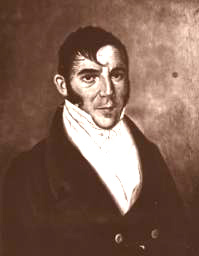Mariano Galvez
| Mariano Gálvez | |
|---|---|

Mariano Galvez in his youth
|
|
|
Governor of Guatemala |
|
|
In office 1831–1838 |
|
| Personal details | |
| Born | ca. 1794 Guatemala City, |
| Died | March 29, 1862 Mexico City, |
| Political party | liberal |
| Residence | Guatemala City, Mexico City |
| Occupation | Lawyer, politician |
| Religion | Catholic |
José Felipe Mariano Gálvez (ca. 1794 – March 29, 1862 in Mexico) was a jurist and Liberal politician in Guatemala. For two consecutive terms from August 28, 1831 to March 3, 1838 he was chief of state of the State of Guatemala, within the Federal Republic of Central America.
Born in the 1790s (some historians give the date August 29, 1790, others May 26, 1794), Gálvez was a foundling left in a basket at the house of Fray Toribio Carvajal. Carvajal gave the child in adoption to the family of Gertrudis Gálvez, one of the wealthiest families of the time, and he received their name. He dedicated himself to study, first at the convent school in Guatemala City and then in the law school at the Royal and Pontifical University of San Carlos Borromeo. He received a doctorate on December 16, 1819.
In the city council of Guatemala City he introduced the motion to end the war between Guatemala and El Salvador. He served as a private counselor to Gabino Gaínza during his administration of the State of Guatemala, and it is probably due to his influence that the latter did not strenuously oppose the popular movement for liberty. After independence, Gálvez favored annexation of Guatemala to Mexico. When the first federal Congress of Central America met in Guatemala in 1825, he was one of the deputies, and he became president of the Congress. In the civil war of 1826, Gálvez took part with the Federalists and headed a revolutionary movement against the Unitarian government, which, though promptly suppressed, hastened the invasion of Guatemala by federalist Francisco Morazán. Gálvez joined Morazán's forces in Ahuachapán.
Member of the liberal party, Mariano Gálvez was appointed chief of state in 1831, during a period of turmoil that made governing difficult; after the expulsion of the conservative leader of the Aycinena family and the regular clergy in 1829, was appointed by Francisco Morazán as Governor of Guatemala in 1831. Liberal historians such as Ramón Rosa and Lorenzo Montúfar y Rivera, refer that he promoted major innovations in all aspects of the administration, to make if less dependent on the Catholic Church influence. It is also reported that he made public instruction independent of the Church, fostered science and the arts, eliminated religious festivals as holidays, founded the National Library and the National Museum, promoted respect for the laws and the rights of citizens, guaranteed freedom of the press and freedom of thought, established civil marriage and divorce, respected freedom of association and promulgating the Livingston Code (penal code of Louisiana), against much opposition from the population who was not used to the fast pace the changes were taking place; he also initiated judicial reform, reorganized municipal government and established a general head tax which severely impacted the native population. However, this were all changes that the liberals wanted to implement to completely eliminate the political and economic power of the aristrocrats and of the Catholic Church -whose regular orders were expelled in 1829 and the secular clergy was weakened by means of abolishing mandatory tithing.
...
Wikipedia
